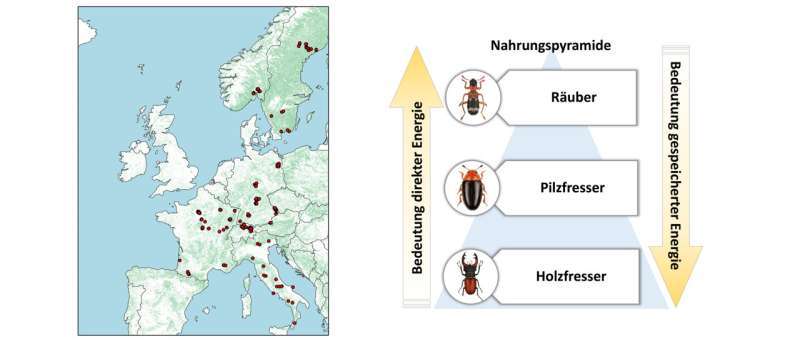This article has been reviewed according to Science X's editorial process and policies. Editors have highlighted the following attributes while ensuring the content's credibility:
fact-checked
peer-reviewed publication
trusted source
proofread
Beetles and their biodiversity in dead wood

Which energy type promotes the biodiversity of beetles living in dead wood in the forest? That depends entirely on where the beetles are in the food chain.
Energy is the key to life. For decades, scientists have been trying to decipher the connection between available energy and biodiversity in ecosystems.
In the process, clear correlations have emerged. For instance, ecosystems with higher energy input, for example due to stronger solar radiation near the equator, are endowed with greater biodiversity. But ecosystems do not exclusively draw their energy directly from the sun. Energy can also be stored chemically, for example in resources such as wood.
Which type of energy promotes biodiversity? Does it happen uniformly along the food chain? These questions have remained unanswered until now.
The first answers have come from researchers at the Julius-Maximilians-Universität (JMU) Würzburg Biocentre. A team led by ecologists Simon Thorn and Peter Kriegel has studied the species diversity of beetles that live in deadwood in forests. Data from all over Europe was collected for this purpose. Simon Thorn initiated and coordinated the project six years ago; he has recently started research at the Hessian Agency for Nature Conservation, Environment and Geology.
Deadwood studied from Scandinavia to Italy
As the researchers show in the journal Ecology Letters, the diversity of deadwood beetles is influenced differently by energy types depending on their position in the food chain. This evidence was obtained with data recorded along a gradient from northern to southern Europe from a total of 2,746 deadwood objects.
"Species like the stag beetle, whose larvae feed directly on dead wood and are thus at the bottom of the food chain, benefit in their diversity from the amount of energy stored in the wood," says Kriegel. "The more sugar compounds are stored in the heartwood, the greater their diversity."
At the top end of the food pyramid of deadwood beetles are species like the ant beetle that eat other insects. Their diversity is largely unaffected by the energy stored in the wood. Instead, greater solar radiation plays an important role here.
Detecting organisms hidden in deadwood
"These results are important for basic ecological research," says JMU forest ecologist Professor Jörg Müller, who was involved in the study. The results could help to slow down alarming developments such as insect decline.
Next, the research team from the JMU Chair of Animal Ecology and Tropical Biology wants to turn its attention to biodiversity in deadwood which is not openly visible.
"Using methods such as DNA sequencing, we want to detect the molecular traces of hidden organisms: Bacteria, fungi without fruiting bodies, but also groups of insects which are difficult to determine and are therefore often neglected," explains Kriegel. Then the question will be whether the respective tree species or the sunlight is more important for a high species diversity.
More information: Peter Kriegel et al, Ambient and substrate energy influence decomposer diversity differentially across trophic levels, Ecology Letters (2023). DOI: 10.1111/ele.14227
Journal information: Ecology Letters
Provided by Julius-Maximilians-Universität Würzburg



















